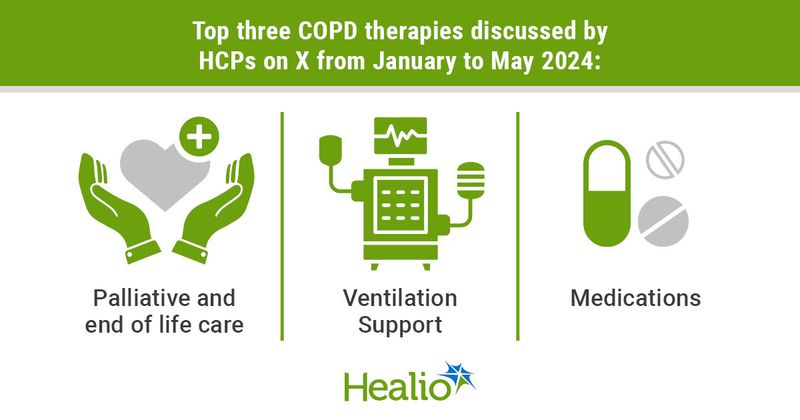Clinicians discuss COPD ventilation support, medications on X in first half of 2024
Key takeaways:
- The rise in discussion of ventilation support was due to two articles published in the June issue of CHEST being shared.
- Many of the posts on COPD medications focused on the NOTUS trial results.
In the first half of 2024, many posts on X, formerly Twitter, from U.S. health care professionals discussing COPD therapies focused on ventilation support, medications and palliative care, according to a tracker from Creation Healthcare.
In an analysis spanning January 2024 to June 2024, Creation Healthcare evaluated 1,493 COPD-related posts on X, to find out major topics discussed by U.S. health care professionals (HCPs) on this platform.

These COPD-related posts came from a total of 750 HCPs, according to the release.
One of the three main topics that researchers captured in this analysis was COPD therapy options, including ventilation support, medications, surgical interventions, palliative and end-of-life care, complementary and alternative therapies, and smoking cessation.
When comparing the number of X posts averaged from January through May vs. June, one therapy with a large rise in posts was ventilation support, going from 12.8 posts to 18 posts.

This rise in discussion was due to two articles published in the June issue of CHEST being shared around, Jamie Doggett, associate director of research at Creation Healthcare, told Healio. Both articles, “Applying Noninvasive Ventilation in Treatment of Acute Exacerbation of COPD Using Evidence-Based Interprofessional Clinical Practice” and “Home Noninvasive Ventilation in COPD” focused on noninvasive ventilation.
Another COPD therapy type with an increased number of X posts was surgical intervention, which went up from an average of 4.4 posts between January and May to nine posts in June.
Doggett said the main reason for this rise was due to a post on June 7 by Daniel Vargas, MD, chief of cardiothoracic radiology at University of Colorado Anschutz Medical Campus, in which he asked for thoughts on a chest radiology case. As of July 31, the post had eight replies (all on the day it was posted), more than a dozen reposts and 88 likes.
When asked if it just takes one post on X to cause an uptick in engagement on a specific topic, Doggett told Healio it depends on a few factors.
“If the person who posts it is influential enough, and the topic they are posting about or resource they are sharing is compelling enough, then yes — one post can have a big impact on HCP conversation levels,” he said.
Both the smoking cessation category and the complementary and alternative therapies category only had one post in June, and this did not differ greatly from their January to May averages of one and 0.67, respectively.
The one therapy type with a relatively consistent number of X posts over the assessed time period was medications. The January to May average was 12 posts and the number of posts in June was 14.
“Of all therapy types (with more than one mention), medications underwent the smallest percentage change in monthly mentions when comparing June with the January to May averages,” Doggett said.
The press release noted that many of these posts focused on the NOTUS trial results of dupilumab (Dupixent; Regeneron, Sanofi) in adults with moderate to severe COPD and type 2 inflammation. These findings were presented at the American Thoracic Society International Conference in May and simultaneously published in The New England Journal of Medicine.
Posts on medications also often discussed FDA priority review given to the drug in February.
Lastly, posts on palliative and end-of-life care declined in June vs. the January to May average (five posts vs. 13.2 posts), but this was not entirely due to month-to-month drops, Doggett told Healio.
“The drop is mostly explained by a spike in conversation in May during ATS which inflated the January to May average, as opposed to a significant month-on-month decline,” Doggett said.
The large number of posts on palliative and end of life care during January to May was a result of findings from the ADAPT trial being published in JAMA. As Healio previously reported, receiving care from a palliative telecare team resulted in more improvements in quality of life than usual care among patients with COPD, interstitial lung disease or heart failure.
Reference:
- Price caps, emerging treatments, and influential voices: HCPs’ online COPD conversations revealed. https://creation.co/press-release/price-caps-emerging-treatments-and-influential-voices-hcps-online-copd-conversations-revealed/. Published July 23, 2024. Accessed Aug. 2, 2024.
